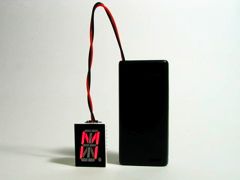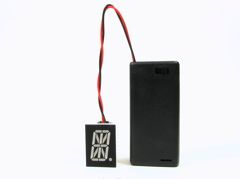
Brad Carter took our stickers to Target and has some great photos to show for it. See More photos at flickr, and Brad’s blog entry about the expedition. Nice work!
(See also the contest from Fake Steve.)





Brad Carter took our stickers to Target and has some great photos to show for it. See More photos at flickr, and Brad’s blog entry about the expedition. Nice work!
(See also the contest from Fake Steve.)
Vintage software documentation often comes in 6″ x 9″ three ring binders which are just the right size for a small handbag. Many of them are cloth bound, making them ideal for reuse. Tech surplus stores such as Weird Stuff are good places to look for interesting covers, like this Pepper Graphics user’s guide from Number Nine. With the addition of a fabric liner and handles it has become an excellent geek purse.
Continue reading Vintage Software Documentation Purse
This trombone cozy was necessitated by a skin allergy to certain metals. It is a rectangle of soft cotton material with velcro sewn on so that it wraps snugly around the portion of the horn that comes in contact with the trombonist’s neck. I measured the length of the tube we wanted to cover, and wrapped a string around it to get the circumference. I added a bit seam allowance and overlap for the velcro to start with a rectangle of material about 3″ x 7″ and a 6.5″ strip of velcro. I rolled a hem around the four sides and sewed the velcro on. Problem solved– no more neck irritation makes for a much happier band member.
The BristleBot is a simple and tiny robot with an agenda. The ingredients? One toothbrush, a battery, and a pager motor. The result? Serious fun.
(YouTube video here.)
The BristleBot is our take on the popular vibrobot, a simple category of robot that is controlled by a single vibrating (eccentric) motor. Some neat varieties include the mint-tin version as seen in Make Magazine (check the video), and the kid’s art bot: a vibrobot with pens for feet.
Continue reading Bristlebot: A tiny directional vibrobot


Time to make some LED Micro-Readerboards as ornaments for your tree this year? Watch the short video introduction to see what they do: display a message one character at a time.
This is one of the open-source holiday electronics projects that we released last year. Our up-to-date build instruction are here, including source code. We also have an FAQ about this project, a page of technical data about it, and a discussion forum if you need help with it. The version 2.0 kits (which are still available at the Make Store) use a seriously awesome ultra-high brightness, deep red 16-segment alphanumeric display for long battery life.
As of today, you can also buy the LED displays alone– just the thing for your own custom microcontroller project, alphapov display, name tag, or ornament.

Next, the Interactive LED Panel Kits (as seen in the interactive LED coffee tables that we designed with Because We Can) now come with these beautiful black printed circuit boards. Pictured above, JellyBean combats a mechanical mouse on a table made with a special-order kit that has all green LEDs.
Quite a few of these tables have now been built and there’s even a new instructable from Deadly Computer about the process of building one. During the past month we’ve slowly caught up with the huge waiting list to get a kit, so it’s much easier to get one now. We have even made up some extras of the most popular kit combinations (8 panel with all blue LEDs or blue + white LEDs), which are available in stock to buy right now, shipped to arrive before Christmas to US addresses.

Finally, we have some new multipurpose stickers for sale. Quite possibly the best gift in the world for the software developer in your life.
“These handy stickers will increase the visual appeal of many different items. If you happen to take them to any big box electronics stores, please bring your camera and post pictures in the Evil Mad Science Auxiliary.” We’re waiting for those action shots.
We used to live in Austin, Texas, and welcomed the Austin Maker Faire this past October as an excuse to go back and visit. We had a great time at the fair, where our high tech pumpkins (especially the snapping pumpkins) garnered several editor’s choice ribbons.
It was really fun to be back in Austin and remember what we loved so much. One of the things we really miss is the food. I took the picture above of the beautiful neon sign at Magnolia, one of the best of restaurants. Not only do they serve really good food, but they’re open 24/8. The distinct lack of independent 24 hour restaurants in silicon valley is somewhat depressing, but we’re glad to see that the culture is still thriving in Austin, where Magnolia has opened a second branch.
Of course, we inevitably also were reminded of what we don’t love so much. You know how they say that everything is bigger in Texas? Well, it’s true about the bugs.
Here’s a simple problem: “How do you make an LED turn on when it gets dark?” You might call it the “nightlight problem,” but the same sort of question comes up in a lot of familiar situations– emergency lights, street lights, silly computer keyboard backlights, and the list goes on.
Solutions? Lots. The time-honored tradition is to use a circuit with a CdS photoresistor, sometimes called a photocell or LDR, for “light-dependent resistor.” (Circuit Example 1, Example 2.) Photoresistors are reliable and cost about $1 each, but are going away because they contain cadmium, a toxic heavy metal whose use is increasingly regulated. There are many other solutions as well. Look here for some op-amp based photodetector circuits with LED output, and check out some of the tricks used in well-designed solar garden lights, which include gems like using the solar cell itself as the sensor. (Our own solar circuit collection is here.)
In this article we show how to build a very simple– perhaps even the simplest– darkness-activated LED circuit. To our LED and battery we add just three components, which cost less than thirty cents altogether (and much less if you buy in bulk). You can build it in less than five minutes or less (much less with practice).
What can you do with such an inexpensive light-controlled LED circuit? Almost anything really. But, one fun application is to make LED throwies that turn themselves off in the daytime to save power. Throwies normally can last up to two weeks. Adding a light-level switch like this can significantly extend their lifetime.
Continue reading A Simple and Cheap Dark-Detecting LED Circuit
Holiday gifts, some math fun, and the usual weirdness.

This Galaga quilt from Carolina Patchworks would make the perfect present for the retro arcade game fan. According to the etsy listing, it “is fully compatible with the XBox 360, Wii, PlayStation III, all high-definition televisions, most models of fireplace, and a wide variety of good books.”
However, only one lucky geek in the world is going to get this seriously underpriced masterwork as their Christmas present this year, so make sure your trigger-finger skills are in tip-top shape before you head on over to etsy.
Thanks, Sean!
Related: QuiltBert
One of our favorite shapes is the Sierpinski triangle. In one sense, a mere mathematical abstraction, on the other, a pattern that naturally emerges in real life from several different simple algorithms. On paper, one can play the Chaos Game to generate the shape (or cheat and just use the java applet).
You can also generate a Sierpinski triangle in what is perhaps a more obvious way: by exploiting its fractal self-similarity.
Continue reading Iterative Algorithmic Plastic Sculpture: Fimo Fractals